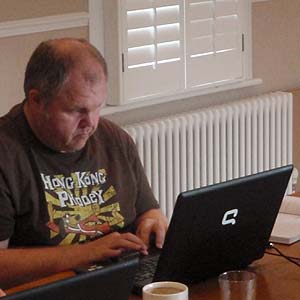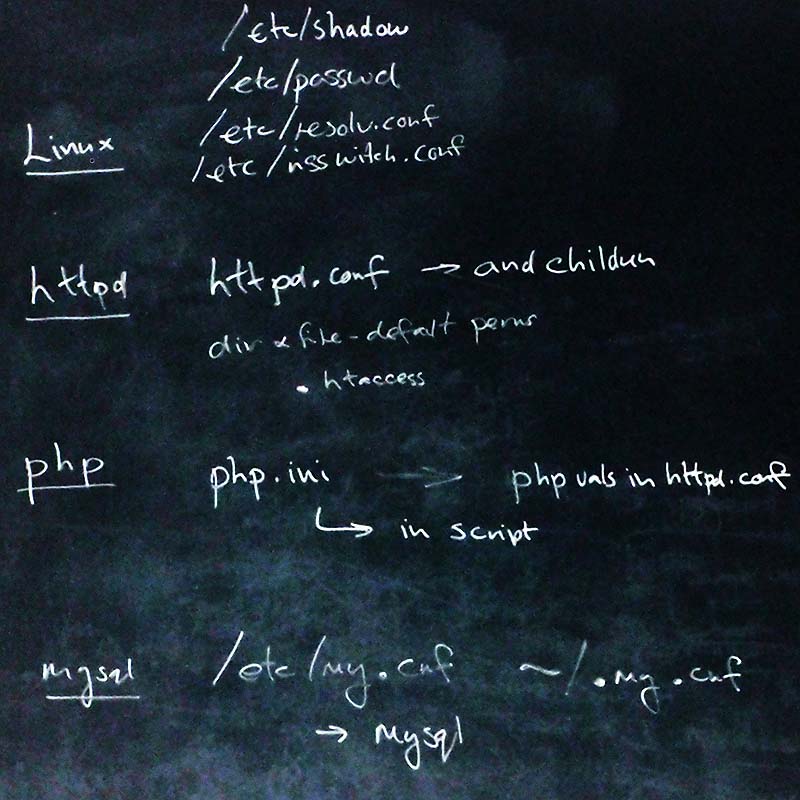
|
Training, Open Source Programming Languages |
| Home | Accessibility | Courses | The Mouth | Resources | Site Map | About Us | Contact |
| For 2023 (and 2024 ...) - we are now fully retired from IT training. We have made many, many friends over 25 years of teaching about Python, Tcl, Perl, PHP, Lua, Java, C and C++ - and MySQL, Linux and Solaris/SunOS too. Our training notes are now very much out of date, but due to upward compatability most of our examples remain operational and even relevant ad you are welcome to make us if them "as seen" and at your own risk. Lisa and I (Graham) now live in what was our training centre in Melksham - happy to meet with former delegates here - but do check ahead before coming round. We are far from inactive - rather, enjoying the times that we are retired but still healthy enough in mind and body to be active! I am also active in many other area and still look after a lot of web sites - you can find an index ((here)) |
|
LAMP - Linux, Apache, MySQL, PHP - install, configure, administer  Linux - Apache - MySQL - PHP. The "LAMP" combination that serves many web sites - including ours - these days. Linux - Apache - MySQL - PHP. The "LAMP" combination that serves many web sites - including ours - these days.Linux provides the underlying computer operating system on which the other elements are built Apache (that's the Apache http web server / httpd) provides the service which listens for requests to the computer for web pages (and associated requests) from user's browsers, and answers those requests with the appropriate data content. MySQL provides databases on the server in which much of the content is typically stored these days PHP provides the programming layer which links the requests made to Apache httpd to the MySQL database and funnels the data from the database back to the user. Actually PHP does much, much more that this ...  Yesterday evening (and I do mean evening - a very keen group of delegates had me splitting sites between servers using mod_rewrite and mod_proxy), I completed a deploying LAMP training course. A typical company web site will run on just one or two servers, but will have thousands of users - so it's natural for all the complexity to be at the server side, and the client to be thin. And PHP, MySQL, Apache httpd and Linux are all Open Source ... like most open source products highly configurable. Roll those two characteristics together and LAMP deployment training is really worthwhile - it means that you know how to make the very best of your server, how it's set up, and where you can pull in extra options and configure it to do exactly what you want. It's not because Apache's free that it accounts for the majority of domains served on the internet - it's because it is good, flexible, secure, and resource light. Yesterday evening (and I do mean evening - a very keen group of delegates had me splitting sites between servers using mod_rewrite and mod_proxy), I completed a deploying LAMP training course. A typical company web site will run on just one or two servers, but will have thousands of users - so it's natural for all the complexity to be at the server side, and the client to be thin. And PHP, MySQL, Apache httpd and Linux are all Open Source ... like most open source products highly configurable. Roll those two characteristics together and LAMP deployment training is really worthwhile - it means that you know how to make the very best of your server, how it's set up, and where you can pull in extra options and configure it to do exactly what you want. It's not because Apache's free that it accounts for the majority of domains served on the internet - it's because it is good, flexible, secure, and resource light. The diagram shown on the right here (click on it for a larger copy in a new window) shows the layout of the file system of a typical Linux box, with the various elements - Apache, MySQL and PHP shown, on the Linux tree - and with the parts of the Linux tree that you'll want to tailor when you set up accounts and do various other configuration jobs. The diagram was built up during the course - I've copied it here for the delegates who attended (and for anyone else who might find it useful), but this is one of those diagrams that can't but help be more useful if you see it being drawn rather than just looking at the final product. The diagram shown on the right here (click on it for a larger copy in a new window) shows the layout of the file system of a typical Linux box, with the various elements - Apache, MySQL and PHP shown, on the Linux tree - and with the parts of the Linux tree that you'll want to tailor when you set up accounts and do various other configuration jobs. The diagram was built up during the course - I've copied it here for the delegates who attended (and for anyone else who might find it useful), but this is one of those diagrams that can't but help be more useful if you see it being drawn rather than just looking at the final product.Even on a diagram such as this, you see the scope for flexibility - there are a number of purple asterisks (*) which show various options we discussed for placing the web content - each a good choice in certain circumstanced. And there are a number of log locations noted which could be the best place for server logs.  One of the things that you'll want to be aware of if you're responsible for a LAMP server are where the main configuration files for each of the elements is located, and that's something we had on the board as well. Again - click on the image to see it much larger! One of the things that you'll want to be aware of if you're responsible for a LAMP server are where the main configuration files for each of the elements is located, and that's something we had on the board as well. Again - click on the image to see it much larger!With many (most?) of the elements here, you'll find this is a simplified view - for within one configuration file you're able to refer on to another, or configuration files are nested. The nsswitch.conf file tells the Linux operating system's programs where to look for its tables of hosts, users, etc ... and it may refer onwards to the network information service (NIS) and the Domain Name Service (DNS). The httpd.conf file for the Apache httpd web server may include calls to subsiduary files for setting up features like virtual hosting, and access to the http server manual; there may also be a whole tree of files called .htaccess within the web site(s) being hosted. The php.ini file for PHP may be overridden by settings within the httpd.conf file and its tree, and in individual pieces of code. And /etc/my.cnf for MySQL will point to most of the setup data stored in tables within the engine itself.  It isn't always L-A-M-P either. It could be U-A-O-P, where U is Unix and O is Oracle, for example. And sometimes the P may change from PHP to Perl or Python. Yet most of the deployment issues remain the same. It isn't always L-A-M-P either. It could be U-A-O-P, where U is Unix and O is Oracle, for example. And sometimes the P may change from PHP to Perl or Python. Yet most of the deployment issues remain the same.For users of Java based web applications written to the JSP or Servlet standard, and extra server (Apache Tomcat) may be included in the deployment configuration, and there may be an extra language to install in the shape of Java too. That's covered on our deploying Apache httpd and Tomcat course - next scheduled at the end of next week.  I've added pictures of the delegates on this course to the blog - with their permission, of course. I'm always tired after a deployment course (for various reasons they require a more intensive presentation than a programming course) but I'm also exhilarated - and especially so with this bunch. The extra questions ... the addition of more content on mod_rewrite and on mod_proxy and the balancer, a deeper practical than usual on virtual hosting all made the four days that much more rewarding for me, and (I'm certain) the course much more relevant for them. I'm delighted that I'll be welcoming one back on a PHP course in the near future, and who knows I might end up learning how to write iPhone and iPad apps with another one over some quiet weekend in the autumn. I've added pictures of the delegates on this course to the blog - with their permission, of course. I'm always tired after a deployment course (for various reasons they require a more intensive presentation than a programming course) but I'm also exhilarated - and especially so with this bunch. The extra questions ... the addition of more content on mod_rewrite and on mod_proxy and the balancer, a deeper practical than usual on virtual hosting all made the four days that much more rewarding for me, and (I'm certain) the course much more relevant for them. I'm delighted that I'll be welcoming one back on a PHP course in the near future, and who knows I might end up learning how to write iPhone and iPad apps with another one over some quiet weekend in the autumn.(written 2010-07-30, updated 2010-07-31) Associated topics are indexed as below, or enter http://melksh.am/nnnn for individual articles A100 - Web Application Deployment - The Components of a Web-Based Solution[34] Linux / LAMP course - (2004-08-31) [49] Business is the predominant user of Tomcat, Perl and Tcl - (2004-09-15) [166] Acronyms - (2005-01-02) [367] Ajax - (2005-07-03) [433] FTP - how to make the right transfers - (2005-09-01) [442] How far away is that server? - (2005-09-10) [510] Dynamic Web presence - next generation web site - (2005-11-29) [673] Helicopter views and tartans - (2006-04-06) [924] The LAMP Cookbook - Linux, Apache, MySQL, PHP / Perl - (2006-11-13) [1176] A pu that got me into trouble - (2007-05-04) [1198] From Web to Web 2 - (2007-05-21) [1265] Apache, Tomcat, Jakarta, httpd, web server - what are they? - (2007-07-13) [1496] PHP / Web 2 logging - (2008-01-06) [2099] Should I maintain the programming code on my own website? - (2009-03-23) [3891] The components of an Apache httpd / Tomcat / MySQL stack and what each does - (2012-10-13)
Some other Articles
Redirecting a page - silent, temporary or permanent?Groupsave tickets - 3 or 4 train tickets for the price of 2 Programming Standards from the start! The Land of the Black Labrador LAMP - Linux, Apache, MySQL, PHP - install, configure, administer Global Computer Maintenance Department Sorting people by their names Exclamation marks and question marks on ruby method names Alternative loops and conditionals in Ruby and Perl Wiltshire Council ask how they can help businesses |
4759 posts, page by page
Link to page ... 1, 2, 3, 4, 5, 6, 7, 8, 9, 10, 11, 12, 13, 14, 15, 16, 17, 18, 19, 20, 21, 22, 23, 24, 25, 26, 27, 28, 29, 30, 31, 32, 33, 34, 35, 36, 37, 38, 39, 40, 41, 42, 43, 44, 45, 46, 47, 48, 49, 50, 51, 52, 53, 54, 55, 56, 57, 58, 59, 60, 61, 62, 63, 64, 65, 66, 67, 68, 69, 70, 71, 72, 73, 74, 75, 76, 77, 78, 79, 80, 81, 82, 83, 84, 85, 86, 87, 88, 89, 90, 91, 92, 93, 94, 95, 96 at 50 posts per pageThis is a page archived from The Horse's Mouth at http://www.wellho.net/horse/ - the diary and writings of Graham Ellis. Every attempt was made to provide current information at the time the page was written, but things do move forward in our business - new software releases, price changes, new techniques. Please check back via our main site for current courses, prices, versions, etc - any mention of a price in "The Horse's Mouth" cannot be taken as an offer to supply at that price.
Link to Ezine home page (for reading).
Link to Blogging home page (to add comments).
PH: 01144 1225 708225 • EMAIL: info@wellho.net • WEB: http://www.wellho.net • SKYPE: wellho
PAGE: http://www.wellho.net/mouth/2896_LAM ... ister.html • PAGE BUILT: Sun Oct 11 16:07:41 2020 • BUILD SYSTEM: JelliaJamb